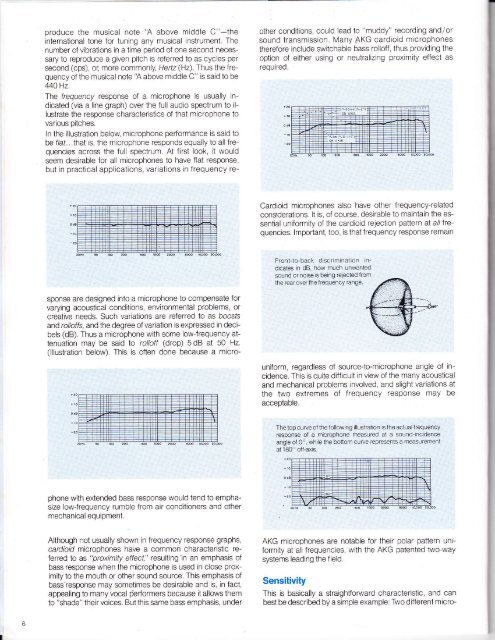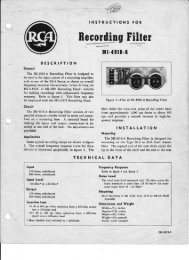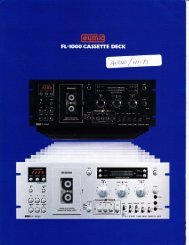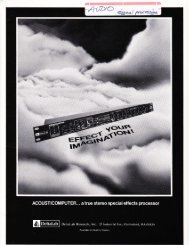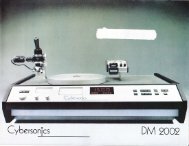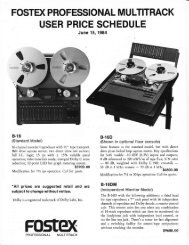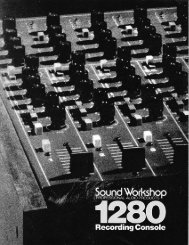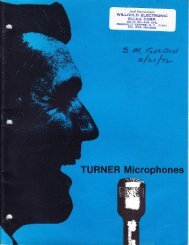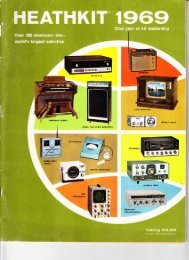AKG_Mics_1978_part1 - Preservation Sound
AKG_Mics_1978_part1 - Preservation Sound
AKG_Mics_1978_part1 - Preservation Sound
Create successful ePaper yourself
Turn your PDF publications into a flip-book with our unique Google optimized e-Paper software.
produce the musical note 'A above middle C"-lhe<br />
internalional tone for tuning any musical instrument. The<br />
number of vib,rations in a time period of one second necessary<br />
to reproduce a given pitch is referred to as cycles per<br />
second (cps), o[ more commonly, Herlz (Hz). Thus the frequency<br />
of the musical note 'A above middle C" ls said to be<br />
440 Hz.<br />
fhe frequency response of a mlcrophone is usually indicated<br />
(via a line graph) over the full audio spectrum to il<br />
lustrate the response characteristlcs of that microphone to<br />
various pitches.<br />
other conditions, could lead to "muddy" recording and/or<br />
sound transmlssion. lVany <strong>AKG</strong> cardioid mjcrophones<br />
therefore include swltchable bass rolloff, thus providlng the<br />
option of either using or neutralzing proximity effect as<br />
required.<br />
Cardioid microphones also have other frequency-related<br />
considerations. lt is, oi course, desirable to maintain the essential<br />
uniformity of the cardio d rejection pattern at a// frequencies.<br />
lmporta'']t. Ioo. is ll^at frequercy 'esponse renain<br />
Front{o back discrimination ind<br />
cates in dB, how much unwanted<br />
sound ornoise is being relecled fiom<br />
the rear overlhe lrequency €nge.<br />
uniform, regardless of source-to-microphone angle of incidence.<br />
This is quite diff icult in vew of the many acousiical<br />
and mechanical problems involved, and slight variations at<br />
the two extremes of frequency response may be<br />
acceptable.<br />
The top curve of the loilow ng illustral on is the actu al freqLrency<br />
response of a microphone measured ai a sound-lncidence<br />
angle ol 0', while the bottom curve represents a rneasuremenl<br />
ar I80'olla: s.<br />
ln the illustrauon below microphone performance is said to<br />
be f/af. ..that is, the microphone responds equally to all fre<br />
quencies across the fu I spectrum. At first look, lt would<br />
seem desirable for all microphones to have flat response,<br />
bul in practical applications, variations in frequency response<br />
are designed into a microphone to compensate for<br />
varying acouslical conditions, environmental problems, or<br />
creative needs. Such variations are referred to as boosls<br />
and rol/offs, and the degree of variation is expressed in decibels<br />
(dB). Thus a microphone with some lowjrequency a!<br />
tenuation may be said to ro off (drop) 5 dB at 50 Hz.<br />
(lllustration below). This is often done because a microphone<br />
with extended bass response would lend to emphasize<br />
lowjrequency rumble from air conditioners and olher<br />
mechanical equipment.<br />
Although not usually shown in frequency response graphs,<br />
cardloid microphones have a common characteristic referred<br />
to as "proximfty effect," resulting'in an emphasis of<br />
bass response when the microphone is used in close proximily<br />
to the mouth or other sound source. This emphasis of<br />
bass'response may sometimes be desirable and is, in fact,<br />
appealing to many vocal derformers because it allows them<br />
1o "shade" their voices. Bul this same bass emphasis, under<br />
<strong>AKG</strong> microphones are notable for their polar pattern uniformity<br />
at all frequencies, with the <strong>AKG</strong> patented two-way<br />
systems leading the f ield.<br />
Sensitivity<br />
This is basically a straightfoMard characteristic, and can<br />
best be described by a simple example: Two different micro-


